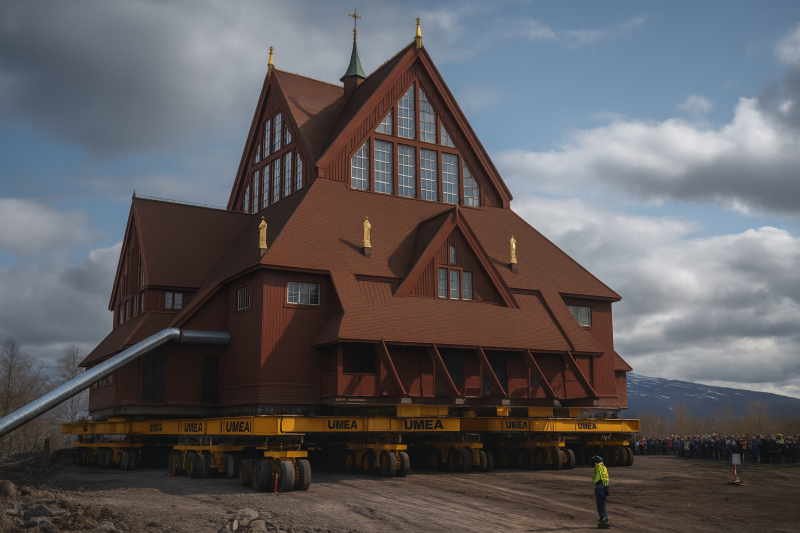
There are moments when you realize that human beings can achieve more than they think. Today is one of those moments. In Kiruna, a 600-ton church is being moved – slowly, carefully, but decisively – toward its new home. A church that has stood on the same ground for more than a hundred years, built of wood, raised in faith and tradition, now literally placed on wheels and sent on a journey.
It is an image that carries something greater than engineering. It is an image of our ability to deal with the uncomfortable. To prove, again and again, that what looks impossible is often just that – uncomfortable, but not impossible.
The city that stood on cracks
Kiruna is a city born from iron ore. When the first houses were built more than a century ago, people already knew that the mountain below hid riches the world would crave. LKAB’s mine, one of the largest in the world, has for decades supplied Sweden and beyond with iron ore.
But riches always come with a price. The deeper the mine stretched, the more the ground above began to give way. Cracks slithered across the land, first barely visible, then increasingly threatening. And there, right in the danger zone, lay the heart of the city – the center, the homes, the schools, the church.
It was as if the earth itself said: “You cannot stay here anymore.” And sometimes that is exactly how life is. The ground shakes, and we have no choice. We must move.
The church that comes along
Among all the buildings affected, one meant more than the rest. Kiruna Church. Inaugurated in 1912, designed in a national romantic style, built entirely of wood and often named one of the most beautiful buildings in Sweden. It was not only a place for worship – it was the soul of the city.
To imagine leaving it behind, tearing it down, or losing it, was unthinkable. So they decided: the church would come along.
And today, it moves. On massive wagons, with millimeter precision, 600 tons of history are carried to the new site where the future Kiruna is taking shape. It is almost poetic – as if the city itself were saying: “We carry our heart with us.”
Uncomfortable – for the people
But for the people of Kiruna, the relocation is not only a technical feat. It is also painful. Homes are torn down, neighborhoods vanish, old streets disappear. People must say goodbye to houses where generations grew up.
You cannot move the smell of a kitchen, the sound of skates on the old schoolyard, or the feeling of walking home from work along the same street you always did. Just like in life: the hardest part of moving is not the physical luggage, but letting go of what you’ve held on to.
And yet. They move. They continue.
The new Kiruna – an opportunity
Out there, a few kilometers from the old center, the new Kiruna is rising. More modern, more sustainable, adapted for the future. New homes, a new town hall, new opportunities.
Of course, it is not the same. But it is not supposed to be. Because sometimes in life we must create new things, not just cling to the old. We must accept that change does not only take away, it also gives us something we cannot yet see.
When life forces us to move
When I see the images from Kiruna, I think: life works the same way. We like to believe that everything is stable. We build our homes, our routines, our lives on a ground we trust. But sometimes the ground cracks.
It could be the job that vanishes, the relationship that ends, the health that fails. Then we stand there, in the middle of the cracks, and realize we cannot stay. It is uncomfortable. It hurts. But it is not impossible.
Because we can, just like Kiruna, carry our “churches” with us – the things that truly matter. Our values, our love, our faith, our memories. Those we bring along. And we can build something new, even if it will not be the same.
A new beginning
The relocation of Kiruna is a reminder that new beginnings are not always a choice. Often, they are a necessity. But they are also a chance.
Sometimes we need to be shaken out of comfort, even when it happens against our will. Change is uncomfortable, but it is in change that we grow. Just as the city does not die, but is reborn, we too can rise when life pushes us into new directions.
Nothing is impossible
So when I see a 600-ton church roll across Kiruna, I cannot help but think: nothing is truly impossible. Humans can move cities, build bridges across seas, go to the moon – and we can move ourselves, again and again, even when we thought we could not.
Uncomfortable? Yes. But not impossible.
And perhaps that is what makes life worth living. That we are, time and again, given the chance to start over, even when the cracks force us to. That we carry our hearts forward, to new places, to new times. Just like Kiruna.

By Chris...

Add comment
Comments